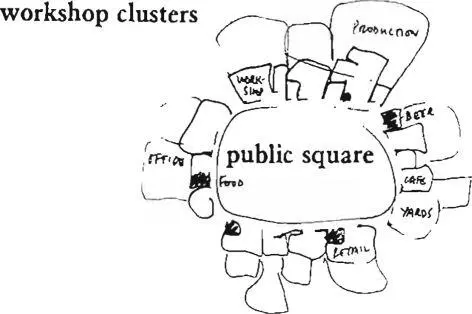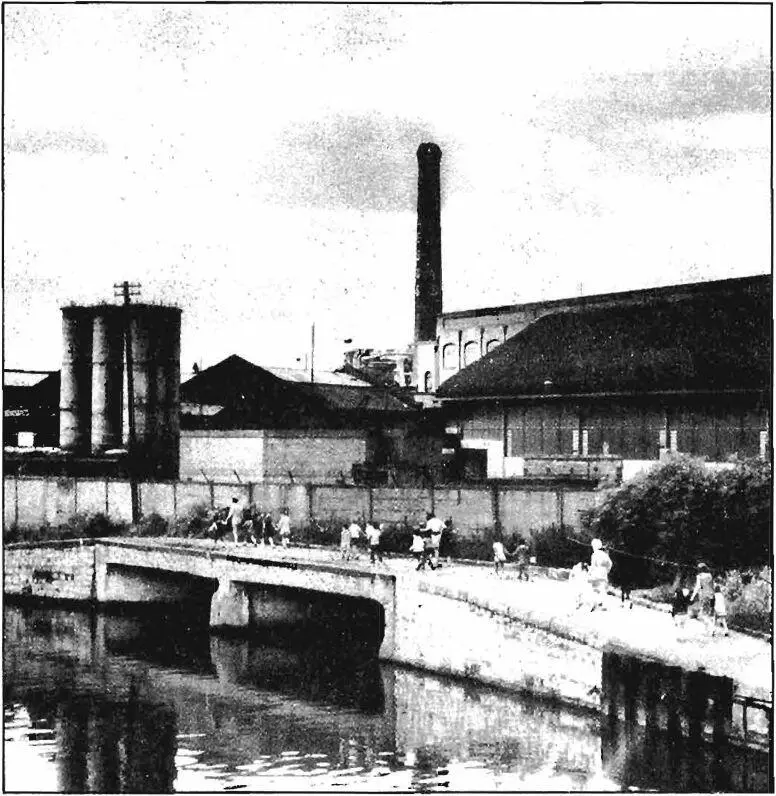Christopher alexander - A pattern language
Здесь есть возможность читать онлайн «Christopher alexander - A pattern language» весь текст электронной книги совершенно бесплатно (целиком полную версию без сокращений). В некоторых случаях можно слушать аудио, скачать через торрент в формате fb2 и присутствует краткое содержание. Жанр: Прочая научная литература, на английском языке. Описание произведения, (предисловие) а так же отзывы посетителей доступны на портале библиотеки ЛибКат.
- Название:A pattern language
- Автор:
- Жанр:
- Год:неизвестен
- ISBN:нет данных
- Рейтинг книги:3 / 5. Голосов: 1
-
Избранное:Добавить в избранное
- Отзывы:
-
Ваша оценка:
- 60
- 1
- 2
- 3
- 4
- 5
A pattern language: краткое содержание, описание и аннотация
Предлагаем к чтению аннотацию, описание, краткое содержание или предисловие (зависит от того, что написал сам автор книги «A pattern language»). Если вы не нашли необходимую информацию о книге — напишите в комментариях, мы постараемся отыскать её.
A pattern language — читать онлайн бесплатно полную книгу (весь текст) целиком
Ниже представлен текст книги, разбитый по страницам. Система сохранения места последней прочитанной страницы, позволяет с удобством читать онлайн бесплатно книгу «A pattern language», без необходимости каждый раз заново искать на чём Вы остановились. Поставьте закладку, и сможете в любой момент перейти на страницу, на которой закончили чтение.
Интервал:
Закладка:
3. There is a common piece of land within the work community, which ties the individual workshops and offices together.
A shared street does a little to tie individual houses and places together; but a shared piece of common land does a great deal
41 WORK COMMUNITY
more. If the workplaces are grouped around a common courtyard where people can sit, play volleyball, eat lunches, it will help the contact and community among the workers.
4. The work community is interlaced with the larger community in which it is located.
A work community, though forming a core community by itself, cannot work well in complete isolation from the surrounding community. This is already discussed to some extent in scattered work (9) and men and women (27). In addition, both work community and residential community can gain by sharing facilities and services—restaurants, cafes, libraries. Thus it makes sense for the work community to be open to the larger community with shops and cafes at the seam between them.
5. Finally , it is necessary that the common land , or court-yards , exist at two distinct and separate levels. On the one hand, the courtyards for common table tennis, volleyball, need half-a-dozen workgroups around them at the most—more would swamp them. On the other hand, the lunch counters and laundries and barbershops need more like 20 or 30 workgroups to survive. For this reason the work community needs two levels of clustering.
Therefore:
 |
| eating places |
Build or encourage the formation of work communities —each one a collection of smaller clusters of workplaces which have their own courtyards, gathered round a larger common square or common courtyard which contains shops and lunch counters. The total work community should have no more than 10 or 20 workplaces in it.
summary of the language
when the major parts of buildings and the outdoor areas have been given their rough shape, it is the right time to give more detailed attention to the paths and squares between the buildings 5
119. ARCADES
120. PATHS AND GOALS
121. PATH SHAPE
122. BUILDING FRONTS
123. PEDESTRIAN DENSITY
124. ACTIVITY POCKETS
125. STAIR SEATS
126. SOMETHING ROUGHLY IN THE MIDDLE
now, with the paths fixed, we come back to the buildings: within the various wings of any one building, work out the fundamental gradients of space, and decide how the movement will connect the spaces in the gradients;
127. INTIMACY GRADIENT
128. INDOOR SUNLIGHT
129. COMMON AREAS AT THE HEART
130. ENTRANCE ROOM
131. THE FLOW THROUGH ROOMS
132. SHORT PASSAGES
133. STAIRCASE AS A STAGE
134. ZEN VIEW
135. TAPESTRY OF LIGHT AND DARK
XXV11
Make the square at the heart of the community a public square with public paths coming through it—small public squares (6i); either in this square, or in some attached space, place opportunities for sports—local sports (72); make sure that the entire community is always within three minutes’ walk of an accessible green (60) ; lay out the individual smaller courtyards in such a way that people naturally gather there—courtyards which live (11 5) ; keep the workshops small—self-governing workshops and offices (80); encourage communal cooking and eating over and beyond the lunch counters—street CAFE (88), FOOD STANDS (93), COMMUNAL EATING (147). . . .
| 42 INDUSTRIAL RIBBON* |
|---|
 |
227
. . . in a city where work is decentralized by scattered work (9), the placing of industry is of particular importance since it usually needs a certain amount of concentration. Like work communities (41), the industry can easily be placed to help in the formation of the larger boundaries between subcultures—subculture boundary (13).
Exaggerated zoning laws separate industry from the rest of urban life completely, and contribute to the plastic unreality of sheltered residential neighborhoods.
It is true, obviously, that industry creates smoke, smells, noise, and heavy truck traffic; and it is therefore necessary to prevent the heaviest industry, especially, from interfering with the calm and safety of the places where people live.
But it is also true that in the modern city industry gets treated like a disease. The areas where it exists are assumed to be dirty and derelict. They are kept to the “other side of the tracks,” swept under the rug. And people forget altogether that the things which surround them in their daily lives—bread, chemicals, cars, oil, gaskets, radios, chairs—are all made in these forbidden industrial zones. Under these conditions it is not surprising that people treat life as an unreal charade, and forget the simplest realities and facts of their existence.
Since the 1930’s various efforts have been made, on behalf of the workers, to make factories green and pleasant. This social welfare approach to the nature of industries is once again unreal, in the opposite direction. A workshop, where things are being made, is not a garden or a hospital. The gardens which surround the new industrial “parks” are more for show than for the workers anyway since a few small inner courts or gardens would be far more useful to the workers themselves. And the contribution of an industrial park to the social and emotional life of the surrounding city is almost nil.
What is needed is a form of industry which is small enough so that it does not need to be so sharply segregated; genuine, so that it seems like a workshop, because it is a workshop; placed
| 42 INDUSTRIAL RIBBON |
|---|
 |
T social welfare “green” industrial 'park.
in such a way that the truck traffic which it generates does not endanger nearby neighborhoods; and formed along the edge of neighborhoods so that it is not a dangerous, forgotten zone, but so that it is a real part of life, accessible to children from the surrounding houses, woven into the fabric of city life, in a way that properly reflects its huge importance in the scheme of things.
But many industries are not small. They need large areas to function properly. A survey of planned industrial districts shows that 71.2 per cent of the industries require 0 to 5.0 acres, 13.6 per cent require 5 to 10 acres, and 9.9 per cent require 10 to 25 acres. (Robert E. Boley, Industrial Districts Restudied: An Analysis of Characteristics , Urban Land Institute, Technical Bulletin No. 41, 1961.) These industries can only fit into a neighborhood BOUNDARY (15) Or SUBCULTURE BOUNDARY (13) if the boundary is wide enough. Ribbons whose width varies between 200 and 500 feet, with sites varying in length between 200 and 2000 feet, will be able to provide the necessary range of one to 25-acre sites in compact blocks, and are still narrow enough to keep communities on opposite sides of the ribbon reasonably connected.
The industrial ribbons require truck access and some rail transport. Truck roads and rail spurs should always be located in the center of fhe ribbon, so that the edges of the ribbon remain open
Читать дальшеИнтервал:
Закладка:
Похожие книги на «A pattern language»
Представляем Вашему вниманию похожие книги на «A pattern language» списком для выбора. Мы отобрали схожую по названию и смыслу литературу в надежде предоставить читателям больше вариантов отыскать новые, интересные, ещё непрочитанные произведения.
Обсуждение, отзывы о книге «A pattern language» и просто собственные мнения читателей. Оставьте ваши комментарии, напишите, что Вы думаете о произведении, его смысле или главных героях. Укажите что конкретно понравилось, а что нет, и почему Вы так считаете.












